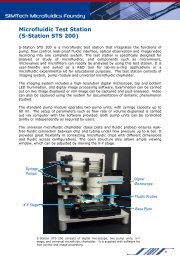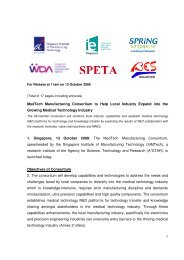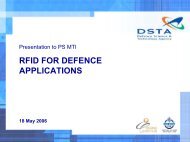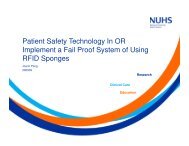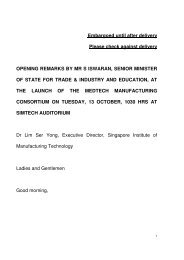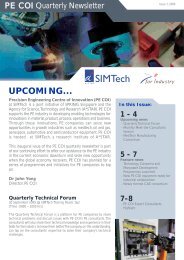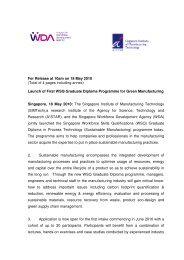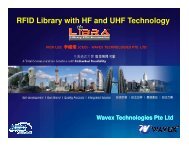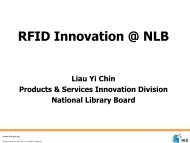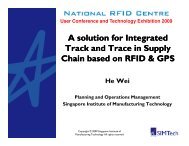RFID Technology - Trends in Asia Pacific - National RFID Centre
RFID Technology - Trends in Asia Pacific - National RFID Centre
RFID Technology - Trends in Asia Pacific - National RFID Centre
You also want an ePaper? Increase the reach of your titles
YUMPU automatically turns print PDFs into web optimized ePapers that Google loves.
<strong>RFID</strong> <strong>Technology</strong> - <strong>Trends</strong> <strong>in</strong> <strong>Asia</strong><br />
<strong>Pacific</strong><br />
Parul Oswal, Industry Analyst<br />
<strong>RFID</strong> & Security<br />
17 th July 2009
Who We Are<br />
• Frost & Sullivan is a global growth consult<strong>in</strong>g company that partners with clients to support<br />
the development of <strong>in</strong>novative growth strategies.<br />
• For more than 40 years, we have leveraged our comprehensive market expertise to serve<br />
an extensive clientele that <strong>in</strong>cludes Global 1000 companies, emerg<strong>in</strong>g companies, and the<br />
<strong>in</strong>vestment community.<br />
• We offer <strong>in</strong>dustry research and market strategies, provide growth consult<strong>in</strong>g and corporate<br />
tra<strong>in</strong><strong>in</strong>g, and support clients to help grow their bus<strong>in</strong>esses.<br />
2
Focus Po<strong>in</strong>ts<br />
1 Market <strong>Trends</strong><br />
2 Standards <strong>in</strong> <strong>Asia</strong> <strong>Pacific</strong><br />
3 <strong>Technology</strong> <strong>Trends</strong><br />
4 Value Cha<strong>in</strong> & Competitive Factors<br />
5 Summary<br />
4
Market Drivers and Restra<strong>in</strong>ts<br />
Rank Driver 1 - 2 Years 3 - 4 Years 5 - 7 Years<br />
1 Strong government support High High Medium<br />
2 Efforts toward standardization High High Medium<br />
3 Expand<strong>in</strong>g application segments High Medium Medium<br />
4 Convergence of technologies Medium Medium High<br />
5 Ris<strong>in</strong>g awareness levels Medium Medium High<br />
Rank Restra<strong>in</strong>t 1 - 2 Years 3 - 4 Years 5 - 7 Years<br />
1 High Cost of <strong>RFID</strong> High High Medium<br />
2 Integration issues at the backend<br />
3 Hiccups from the current<br />
recession<br />
High Medium Medium<br />
High Medium Low<br />
4 Privacy and security concerns Medium Medium Low<br />
5
<strong>Asia</strong> <strong>Pacific</strong> <strong>RFID</strong> Market: Revenue Forecasts<br />
Revenues ($ M illion)<br />
3000.0<br />
CAGR: 21.1%<br />
40.0%<br />
20.0%<br />
Revenue Growth Rate<br />
• Grow<strong>in</strong>g at a CAGR of 21.1<br />
percent from 2008 to 2015<br />
• Vendors are constantly<br />
<strong>in</strong>novat<strong>in</strong>g new products to<br />
survive the competition<br />
0.0<br />
2005 2006 2007 2008 2009 2010 2011 2012 2013 2014 2015<br />
0.0%<br />
Year<br />
Readers<br />
23.6%<br />
Middleware<br />
12.0%<br />
• <strong>RFID</strong> hardware (tags and<br />
readers) accounted for 88.0<br />
Tags<br />
64.4%<br />
percent of the market <strong>in</strong> 2008<br />
•Middleware accounted for the<br />
rema<strong>in</strong><strong>in</strong>g 12.0 percent<br />
Note: All figures are rounded; the base year is 2008.<br />
Source: Frost & Sullivan<br />
6
Revenue Percentage Split by <strong>Technology</strong><br />
Semi-passive<br />
tags<br />
0.4%<br />
Active Tags<br />
10.1%<br />
Hybrid Readers<br />
7.8%<br />
Active Readers<br />
20.4%<br />
Passive Tags<br />
89.5%<br />
Passive Readers<br />
71.8%<br />
Note: All figures are rounded; the base year is 2008. Source: Frost & Sullivan<br />
• Passive tags are currently the largest, while semi- passive are expected to show high growth<br />
rates dur<strong>in</strong>g the forecast period at 70.9 percent, with negligible market share <strong>in</strong> 2008. Active tags<br />
market will cont<strong>in</strong>ue to <strong>in</strong>crease at 45.8 percent dur<strong>in</strong>g the forecast period.<br />
• Passive readers <strong>in</strong> <strong>Asia</strong> <strong>Pacific</strong> comprise 71.8 percent of the market <strong>in</strong> 2008, with their demand<br />
<strong>in</strong>creas<strong>in</strong>g throughout the forecast period, while active readers comprised 20.4 percent, and<br />
hybrid market is still nascent, with limited usage contribut<strong>in</strong>g 7.8 percent <strong>in</strong> the base year.<br />
7
Vertical Market <strong>Trends</strong><br />
100.0%<br />
Revenues (%)<br />
0.0%<br />
Note: All figures are rounded; the base year is<br />
2008.Source: Frost & Sullivan<br />
• Supply cha<strong>in</strong> management is expected to have the highest revenue share <strong>in</strong> 2015, followed by the<br />
more traditional security, access control, and asset track<strong>in</strong>g and transportation applications<br />
• Security, access control, and asset track<strong>in</strong>g and transportation were the largest applications for <strong>RFID</strong><br />
<strong>in</strong> <strong>Asia</strong> <strong>Pacific</strong> <strong>in</strong> 2008.<br />
2005 2006 2007 2008 2009 2010 2011 2012 2013 2014 2015<br />
Supply Cha<strong>in</strong> Management<br />
Security, Asset Track<strong>in</strong>g, and Access Control<br />
Healthcare<br />
• By 2015, supply cha<strong>in</strong> management is expected to become the largest application segment, while the<br />
more traditional applications will hold a marg<strong>in</strong>ally lower market share.<br />
Year<br />
Transportation<br />
Livestock<br />
Others<br />
8
Expand<strong>in</strong>g Application Segment<br />
Oil & Gas<br />
M<strong>in</strong><strong>in</strong>g<br />
Jewellery<br />
Liquor<br />
Document/<br />
Certificates<br />
Bill Boards<br />
CD/ DVD<br />
Street Lamps<br />
Prisoner Laundry Manhole<br />
Flower<br />
Sports Tim<strong>in</strong>g<br />
Footballers<br />
Cas<strong>in</strong>o Chips<br />
Vend<strong>in</strong>g Mach<strong>in</strong>e<br />
Source: Frost & Sullivan<br />
9
UHF Regulatory Status <strong>in</strong> <strong>Asia</strong> <strong>Pacific</strong><br />
Country Regulation Frequency Power Technique Comments Regulator<br />
Australia In place 920 to 926 MHz 4 W eirp 4 W EIRP available<br />
through license,<br />
managed by GS1<br />
Australia. Situation<br />
likely to cont<strong>in</strong>ue until<br />
2007, when it is hoped<br />
that a permanent<br />
change to a limit of 4<br />
W EIRP will take place<br />
Australian Communications<br />
and Media Authority (ACMA)<br />
International Radiocommunications<br />
Bangladesh NA Bangladesh<br />
Telecommunication<br />
Regulatory Commission<br />
(BTRC)<br />
Cambodia NA M<strong>in</strong>istry of Posts and<br />
Telecommunications<br />
Ch<strong>in</strong>a In place 840.5 to 844.5<br />
MHz<br />
920.5 to 924.5<br />
MHz<br />
2 W erp FHSS Available, s<strong>in</strong>ce May<br />
2007<br />
2 W erp FHSS<br />
M<strong>in</strong>istry of Information<br />
Industry<br />
Hong Kong In place 865 to 868 MHz<br />
920-925 MHz<br />
2 W erp<br />
4 W eirp<br />
Office of the<br />
Telecommunications<br />
Authority (OFTA) of the<br />
Hong Kong special<br />
adm<strong>in</strong>istrative region<br />
India In place 865 to 867 MHz 4 W erp Approved <strong>in</strong> May 2005 Telecom Regulatory<br />
Authority of India (TRAI)<br />
Source: Frost & Sullivan<br />
10
UHF Regulatory Status <strong>in</strong> <strong>Asia</strong> <strong>Pacific</strong> (Contd…)<br />
Indonesia In Progress Band 923 to 925 MHz<br />
be<strong>in</strong>g considered<br />
Japan In place 952 to 954MHz 4 W eirp LBT License required for<br />
us<strong>in</strong>g 952 to 954 MHz<br />
at 4 W eirp<br />
Directorate General of Posts<br />
and Telecommunications<br />
(Postel)<br />
International Affairs<br />
Department,<br />
Telecommunications Bureau<br />
Macau<br />
NA<br />
952 to 955MHz<br />
LBT<br />
4 W eirp LBT 952 to 955 MHz<br />
available for unlicensed<br />
use at 20 milliwatts eirp<br />
Malaysia In place 866 to 869 MHz Allocation under<br />
consideration. 868 MHz<br />
available at 50<br />
milliwatts<br />
Malaysian Communications<br />
and Multimedia Commission<br />
(MCMC)<br />
919 to 923 MHz 2 W erp Unlicensed use allowed<br />
up to 2 W erp. Use up<br />
to 4 W erp allowed<br />
under license<br />
Mongolia<br />
NA<br />
New Zealand In place 864 to 868 MHz 4 W eirp M<strong>in</strong>istry of Economic<br />
Development<br />
Pakistan<br />
The<br />
Philipp<strong>in</strong>es<br />
NA<br />
In Progress 918 to 920 MHz 0.5 W erp In progress Department of<br />
Transportation and<br />
Communications (DOTC)<br />
Source: Frost & Sullivan<br />
11
UHF Regulatory Status <strong>in</strong> <strong>Asia</strong> <strong>Pacific</strong> (Contd…)<br />
S<strong>in</strong>gapore In place 866 to 869 MHz 0.5 W erp InfoComm Development<br />
Authority (IDA) of S<strong>in</strong>gapore<br />
920 to 925 MHz 2 W erp<br />
South Korea In place 908.5 to 910 MHz 4 W eirp LBT Approved <strong>in</strong> July 2004 Korea Communications<br />
Commission<br />
Taiwan In place 922 to 928 MHz 1 W erp FHSS Indoor M<strong>in</strong>istry of Information and<br />
Communications (MIC)<br />
922 to 928 MHz 0.5 W erp FHSS Outdoor<br />
Thailand In place 920 to 925 MHz 4 W eirp FHSS New regulations<br />
effective, s<strong>in</strong>ce 20th<br />
January 2006. License<br />
required for power<br />
above 0.5 W<br />
<strong>National</strong><br />
Telecommunications<br />
Commission (NTC)<br />
Vietnam In place 866 to 869 MHz 0.5 W erp M<strong>in</strong>istry of Posts and<br />
Telematics<br />
920 to 925 MHz 2 W erp License required for<br />
power above 0.5 W erp<br />
Source: Frost & Sullivan<br />
12
<strong>RFID</strong> Tags Developments and <strong>Trends</strong><br />
Developments to Improve Quality and<br />
Features for Track<strong>in</strong>g Everyday Items<br />
Developments to Overcome<br />
Uncerta<strong>in</strong>ty <strong>in</strong> ROI<br />
Chipless <strong>RFID</strong><br />
<strong>Technology</strong><br />
Surface Acoustic<br />
Waves (SAW)<br />
Pr<strong>in</strong>table <strong>RFID</strong><br />
<strong>Technology</strong><br />
(Conductive Inks)<br />
Polymer Based <strong>RFID</strong><br />
Chips<br />
M<strong>in</strong>iaturization<br />
(Powder Chips)<br />
Sensory Tags<br />
Strap Form Factors<br />
Lam<strong>in</strong>ar Batteries<br />
DNA Tags<br />
Developments to Overcome<br />
Privacy and Security Issues<br />
Clipped Tags<br />
Push Button Tags<br />
Password Tags<br />
Communication with<br />
Other Technologies<br />
(<strong>in</strong>clud<strong>in</strong>g Mobile Phones)<br />
13
<strong>RFID</strong> Reader Development and <strong>Trends</strong><br />
Intel Reader Chipset<br />
Dense Reader Mode<br />
Shift of Middleware to<br />
Readers<br />
• Expected to br<strong>in</strong>g different<br />
form factors s<strong>in</strong>ce size<br />
reductions to about half<br />
• A high performance UHF<br />
reader radio chip and highly<br />
<strong>in</strong>tegrated.<br />
• Cost reduction due to lower<br />
design complexity. Increase<br />
the reliability and enable a<br />
range of UHF <strong>RFID</strong><br />
applications.<br />
• Dense Reader Mode (DRM)<br />
feature is found <strong>in</strong> most<br />
<strong>in</strong>dustrial based readers. It<br />
is a mode of operation that<br />
can avoid readers from<br />
<strong>in</strong>terfer<strong>in</strong>g with other<br />
readers when <strong>in</strong> close<br />
proximity to one another. It<br />
thus improves the overall<br />
read rate accuracy.<br />
• Introduction of <strong>in</strong>telligent<br />
readers, will require parts of<br />
middleware components will<br />
be added <strong>in</strong>to the reader.<br />
This will <strong>in</strong>directly reduce<br />
the role of the middleware<br />
based <strong>in</strong> centralized<br />
locations.<br />
14
<strong>RFID</strong> Middleware Developments and <strong>Trends</strong><br />
Middleware <strong>Technology</strong> <strong>Trends</strong><br />
Secure shar<strong>in</strong>g of <strong>in</strong>formation with advent of EPCIS<br />
Better device management and scalability- ability to converge with sensors<br />
and other <strong>in</strong>put/ output devices- Intelligent Sensor Networks (ISN)<br />
Intelligence mov<strong>in</strong>g towards the edge of the network to reduce data<br />
process<strong>in</strong>g at centralized locations<br />
Enterprise Middleware Suites mov<strong>in</strong>g towards service oriented architecture (SOA)<br />
Enables complex bus<strong>in</strong>ess logic leverag<strong>in</strong>g on bus<strong>in</strong>ess <strong>in</strong>telligence<br />
and analytics<br />
• Consolidation <strong>in</strong> the middleware <strong>in</strong>dustry<br />
• Very few pure middleware vendors, most<br />
have it as part of their products, services<br />
and implementation.<br />
• Large companies focus on provid<strong>in</strong>g<br />
enterprise-based solutions , embed <strong>RFID</strong><br />
solutions with<strong>in</strong> their products.<br />
Decl<strong>in</strong>e of pure<br />
middleware vendors<br />
• Companies are develop<strong>in</strong>g their own middleware<br />
rather than rely<strong>in</strong>g on external parties.<br />
• Even system <strong>in</strong>tegrators are also beg<strong>in</strong>n<strong>in</strong>g to<br />
develop their own middleware suites besides<br />
offer<strong>in</strong>g the traditional services.<br />
System <strong>in</strong>tegrators<br />
develop<strong>in</strong>g own<br />
middleware suites<br />
Middleware<br />
Market<br />
<strong>Trends</strong><br />
Preference to leverage<br />
on <strong>in</strong>-house talent to<br />
develop middleware<br />
Enterprise solution<br />
companies offer<strong>in</strong>g <strong>RFID</strong><br />
enabled middleware<br />
15
<strong>RFID</strong> Market: Value Cha<strong>in</strong> Analysis<br />
IC<br />
Manufact<br />
urers<br />
Support<strong>in</strong>g Infrastructure<br />
Storage<br />
and<br />
servers<br />
Back End<br />
Networks<br />
Inlay<br />
manufa<br />
cturers<br />
Reader<br />
chipset<br />
manufa<br />
cturer<br />
Others<br />
Smart label,<br />
pr<strong>in</strong>ter<br />
manufacturer<br />
Tag<br />
Manufa<br />
cturers<br />
Reader<br />
manufa<br />
cturer<br />
Middleware<br />
developers<br />
Front End<br />
Auxiliary<br />
Bodies &<br />
services<br />
System<br />
<strong>in</strong>tegrators<br />
End User<br />
Source: Frost & Sullivan<br />
• In most cases, end user will only <strong>in</strong>teract with<br />
the system <strong>in</strong>tegrator, but will know of the<br />
existence of the products under the ‘front end’<br />
category, where the product supplied by the<br />
SI has the company brand clearly visible.<br />
• Back end category, is where IC, <strong>in</strong>lay and<br />
reader chipset manufacturers donot have<br />
<strong>in</strong>teraction with SIs. Only larger SIs which<br />
have personnel with vast expertise may have<br />
relationships with every segment <strong>in</strong> the <strong>RFID</strong><br />
value cha<strong>in</strong> to ensure successful transfer of<br />
knowledge<br />
• Most companies <strong>in</strong> other segments of the<br />
<strong>RFID</strong> value cha<strong>in</strong> have relationships with the<br />
immediate segments and only larger<br />
companies may have professional<br />
relationships with all segments<br />
16
<strong>RFID</strong> Competitive Factors<br />
Ability to<br />
Provide a<br />
Unique<br />
Solution<br />
Portfolio of<br />
Products<br />
Offered<br />
Features,<br />
Functionalit<br />
y and Ease<br />
of Use<br />
Relationshi<br />
p and After<br />
Sales<br />
Support<br />
Key Competitive Factors<br />
Overall<br />
Implementa<br />
tion Cost<br />
Ability to<br />
Integrate<br />
with<br />
Backend<br />
Systems<br />
Technical<br />
Features –<br />
ReadRange<br />
, Accuracy,<br />
Reliability<br />
17
To Summarize<br />
Present Market Conditions<br />
<strong>RFID</strong> is expected to eventually have a huge impact on the daily lives of humans as it<br />
becomes <strong>in</strong>creas<strong>in</strong>gly more ubiquitous support<strong>in</strong>g a myriad of applications. However,<br />
<strong>RFID</strong> stakeholders need to overcome certa<strong>in</strong> issues related to standards and manag<strong>in</strong>g<br />
expectations regard<strong>in</strong>g the true capabilities of <strong>RFID</strong> technology.<br />
With the current economic downturn, companies need to tighten their budgets, and<br />
strategically focus on areas with high potential, rather than focus on all the areas and<br />
not witness any positive result. They need to specialize <strong>in</strong> niche areas <strong>in</strong> order to grow<br />
and be recognized <strong>in</strong> the market.<br />
The <strong>in</strong>dustry is expected to undergo consolidation ow<strong>in</strong>g to prolonged period of slow<br />
sales prospects and tight credit, dur<strong>in</strong>g the current crisis.<br />
Companies need to be <strong>in</strong>novative so that they do not lose competitiveness <strong>in</strong> these<br />
try<strong>in</strong>g times. <strong>RFID</strong>-related companies are likely to re-evaluate the pric<strong>in</strong>g of their<br />
products and services to ensure traction for <strong>RFID</strong> deployments cont<strong>in</strong>ues.<br />
There is still high potential for newer applications to be developed, vendors need to<br />
show uniqueness and <strong>in</strong>novation, provid<strong>in</strong>g appropriate solution to specific problem.<br />
Future Market Conditions<br />
18
For Additional Information<br />
Parul Oswal<br />
Industry Analyst<br />
<strong>RFID</strong> & Security<br />
65- 6890 0974<br />
parul.oswal@frost.com<br />
Thank You<br />
Lennon Tan<br />
Strategic Account Manager<br />
Industrial Practice – <strong>Asia</strong> <strong>Pacific</strong><br />
(65) 6890 0280<br />
lennon.tan@frost.com<br />
19



